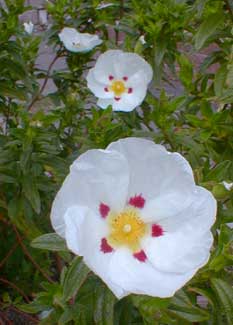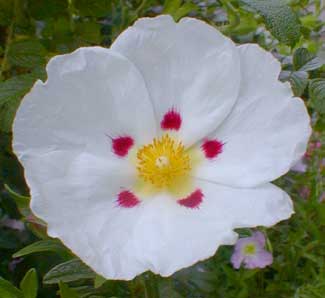
Crimson-spot Rockrose;
or, Spanish Gum Cistus
"Twas not in the Winter
Our loving lot was cast;
It was the time of rose--
We pluck'd them as we pass'd!"
-Thomas Hood
(1798-1845)
(1798-1845)
 The flowers of Crimson Rock Rose (Cistus ladanifer maculatus) are mainly white, with five crimson spots (one per petal) surrounding yellow stamens.
The flowers of Crimson Rock Rose (Cistus ladanifer maculatus) are mainly white, with five crimson spots (one per petal) surrounding yellow stamens.This unique spotted appearance is not shared with many other rockroses, although it is vaguely similar to the Hillier's Shrubby Rockrose ( Halimiocistus wintonensis), the smaller blooms of which have magenta smudges at the base of each flower petal.
Each bloom of the Crimson-spot rockrose is quite big & can be as much as three inches across.
This evergreen shrub grows to three or four feet tall & equally wide. Its long slender leaves, green with greyish undersides, are fragrant in summer, being a major source of redolent essential oils, leaf distillates, & a resin called gum labdanum, used for perfumed products & flavoring. It is often harvested from the wild but is also cultivated for the resins in Spain, Portugal, Cyprus, Crete, & the Esterel Mountains of southern France.
Labdanum was formerly believed to have healing properties for treatment of flu, arthritis, & bronchial infections. It is still sometimes used for numerous health purposes, especially in Mediterranean & African folk medicine. Not all its uses are hokum, as the resins have at least antioxidant properties.
It is sometimes identified with the biblical Rose of Sharon [Isaiah 35:1; Song of Solomon 2:1], & can today be found flowering on Mount Carmel. So too, because it was a source of medicinal Labdanum, it has been associated with Jeremiah's Balm of Gilead.
As with other rock roses, it requires full sun in a xeriscape garden. Ours grows in a great deal of sun at the corner edge of a rugosa rose garden. It makes it through our rainy seasons very easily so long as soil drains well. It thrives in poor soil & requires no fertilizing; too much attention will be more harmful than good for it.
Suited for USDA zones 8 through 10, it is cold hardy for the mild winters on Puget Sound, but may suffer some tip-damage from dessicating winter winds or if temperatures fall to ten degrees Fahrenheit. Thinning by pruning at winter's end, before emergence of fresh spring foliage, will quickly restore it.